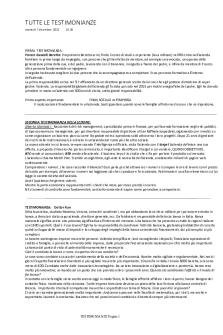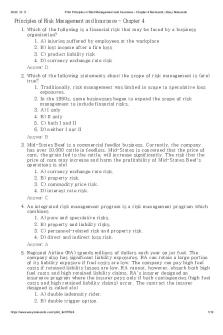21. Print Economics of Money Chapter 21 flashcards Easy Notecards PDF

| Title | 21. Print Economics of Money Chapter 21 flashcards Easy Notecards |
|---|---|
| Course | Principles of Economics |
| Institution | Trường Đại học Kinh tế Thành phố Hồ Chí Minh |
| Pages | 5 |
| File Size | 91.8 KB |
| File Type | |
| Total Downloads | 18 |
| Total Views | 149 |
Summary
Quyết định tài trợ không làm tăng giá trị nhiều như quyết định đầu tư
nhưng chúng có thể phá hủy giá trị...
Description
17/7/2021
Print Economics of Money: Chapter 21 flashcards | Easy Notecards
Economics of Money: Chapter 21 1. Because prices are slow to move in the short-run, when the Federal Reserve lowers the federal funds rate 1. A) nominal interest rates rise. 2. B) real interest rates fall. 3. C) inflation falls. 4. D) real interest rates rise. Answer: B 2. Because prices are sticky in the short-run, when the Federal Reserve raises the federal funds rate 1. A) nominal interest rates fall. 2. B) real interest rates rise. 3. C) inflation falls. 4. D) real interest rates fall. Answer: B 3. The monetary policy (MP) curve indicates the relationship between 1. A) the Federal Funds Rate and the real interest rate. 2. B) the Federal Funds Rate and the inflation rate. 3. C) the inflation rate and the expected inflation rate. 4. D) the real interest rate the central bank sets and the inflation rate. Answer: D 4. The upward slope of the MP curve indicates that 1. A) the central bank lowers real interest rates when inflation rises. 2. B) the central bank raises real interest rates when inflation falls. 3. C) the central bank raises nominal interest rates when inflation rises. 4. D) the central bank raises real interest rates when inflation rises. Answer: D 5. The Taylor Principle states that central banks raise nominal rates by ________ than any rise in expected inflation so that real interest rates ________ when there is a rise in inflation. 1. A) less; rise 2. B) more; fall 3. C) less; fall 4. D) more; rise Answer: D 6. An autonomous tightening of monetary policy 1. A) causes an upward movement along the monetary policy curve. 2. B) causes a downward movement along the monetary policy curve. 3. C) shifts the monetary policy curve upward. 4. D) shifts the monetary policy curve downward. Answer: C 7. An autonomous easing of monetary policy https://www.easynotecards.com/print list/68412
1/5
17/7/2021
Print Economics of Money: Chapter 21 flashcards | Easy Notecards
1. A) causes an upward movement along the monetary policy curve. 2. B) causes a downward movement along the monetary policy curve. 3. C) shifts the monetary policy curve upward. 4. D) shifts the monetary policy curve downward. Answer: D 8. Based on the Taylor Principle, a central bank's endogenous response of raising interest rates when inflation rises 1. A) causes an upward movement along the monetary policy curve. 2. B) causes a downward movement along the monetary policy curve. 3. C) shifts the monetary policy curve upward. 4. D) shifts the monetary policy curve downward. Answer: A 9. Based on the Taylor Principle, a central bank's endogenous response of decreasing interest rates when inflation falls 1. A) causes an upward movement along the monetary policy curve. 2. B) causes a downward movement along the monetary policy curve. 3. C) shifts the monetary policy curve upward. 4. D) shifts the monetary policy curve downward. Answer: B 10. Inflationary pressures caused the FOMC to increase the federal funds rate by ¼ of a percentage point in June 2004, and by exactly the same amount at every subsequent FOMC meeting through June of 2006. Theses actions 1. A) caused an upward movement along the monetary policy curve. 2. B) caused a downward movement along the monetary policy curve. 3. C) shifted the monetary policy curve upward. 4. D) shifted the monetary policy curve downward. Answer: A 11. The Fed's policy actions of reacting to higher inflation by raising the real interest rate during 20042006 were 1. A) upward movements along the monetary policy curve. 2. B) downward movement along the monetary policy curve. 3. C) upward shifts of the monetary policy curve. 4. D) downward shifts of the monetary policy curve. Answer: A 12. When the financial crisis started in August 2007, inflation was rising and the Fed began an aggressive easing lowering of the federal funds rate, which indicated that 1. A) the Fed pursued an autonomous monetary policy tightening. 2. B) the Fed pursued an autonomous monetary policy easing. 3. C) the Fed had an automatic negative response to inflation based on the Taylor rule. 4. D) the Fed had an automatic positive response to inflation based on the Taylor rule. Answer: B https://www.easynotecards.com/print list/68412
2/5
17/7/2021
Print Economics of Money: Chapter 21 flashcards | Easy Notecards
13. When the financial crisis started in August 2007, inflation was rising and the Fed began an aggressive easing lowering of the federal funds rate, which indicated that 1. A) there was an upward movement along the monetary policy curve. 2. B) there was a downward movement along the monetary policy curve. 3. C) the monetary policy curve shifted upward. 4. D) the monetary policy curve shifted downward. Answer: D 14. In deriving the aggregate demand curve a ________ inflation rate leads the central bank to ________ real interest rates, thereby ________ the level of equilibrium aggregate output. 1. A) higher; raise; lowering 2. B) lower; raise; lowering 3. C) higher; lower; lowering 4. D) higher; lower; raising Answer: A 15. The aggregate demand curve is downward sloping because a higher inflation rate leads the central bank to raise ________ interest rates, thereby ________ the level of equilibrium aggregate output., everything else held constant. 1. A) real; lowering 2. B) real; raising 3. C) nominal; lowering 4. D) nominal; raising Answer: A 16. The aggregate demand curve is downward sloping because a higher inflation rate leads the central bank to ________ real interest rates, thereby ________ the level of equilibrium aggregate output., everything else held constant. 1. A) raise; lowering 2. B) raise; raising 3. C) reduce; lowering 4. D) reduce; raising Answer: A 17. Everything else held constant, an increase in government spending will cause 1. A) aggregate demand to increase. 2. B) aggregate demand to decrease. 3. C) the quantity of aggregate demand to increase. 4. D) the quantity of aggregate demand to decrease. Answer: A 18. Everything else held constant, an autonomous easing of monetary policy will cause 1. A) the quantity of aggregate demand to increase. 2. B) the quantity of aggregate demand to decrease. 3. C) aggregate demand to decrease. 4. D) aggregate demand to increase. Answer: D https://www.easynotecards.com/print list/68412
3/5
17/7/2021
Print Economics of Money: Chapter 21 flashcards | Easy Notecards
19. Everything else held constant, an autonomous tightening of monetary policy will cause 1. A) the quantity of aggregate demand to increase. 2. B) the quantity of aggregate demand to decrease. 3. C) aggregate demand to increase. 4. D) aggregate demand to decrease. Answer: D 20. Everything else held constant, an autonomous easing of monetary policy will cause 1. A) aggregate demand to increase. 2. B) aggregate demand to decrease. 3. C) the quantity of aggregate demand to increase. 4. D) the quantity of aggregate demand to decrease. Answer: A 21. Everything else held constant, an increase in autonomous consumer spending will cause the IS curve to shift to the ________ and aggregate demand will ________. 1. A) right; increase 2. B) right; decrease 3. C) left; increase 4. D) left; decrease Answer: A 22. Everything else held constant, a decrease in autonomous consumer spending will cause the IS curve to shift to the ________ and aggregate demand will ________. 1. A) right; increase 2. B) right; decrease 3. C) left; increase 4. D) left; decrease Answer: D 23. Everything else held constant, an increase in autonomous planned investment spending will cause the IS curve to shift to the ________ and aggregate demand will ________. 1. A) right; increase 2. B) right; decrease 3. C) left; increase 4. D) left; decrease Answer: A 24. Everything else held constant, a decrease in autonomous planned investment spending will cause the IS curve to shift to the ________ and aggregate demand will ________. 1. A) right; increase 2. B) right; decrease 3. C) left; increase 4. D) left; decrease Answer: D
https://www.easynotecards.com/print list/68412
4/5
17/7/2021
Print Economics of Money: Chapter 21 flashcards | Easy Notecards
25. Everything else held constant, a decrease in net taxes will cause the IS curve to shift to the ________ and aggregate demand will ________. 1. A) right; increase 2. B) right; decrease 3. C) left; increase 4. D) left; decrease Answer: A 26. Everything else held constant, an increase in net taxes will cause the IS curve to shift to the ________ and aggregate demand will ________. 1. A) right; increase 2. B) right; decrease 3. C) left; increase 4. D) left; decrease Answer: D 27. Everything else held constant, an appreciation of the domestic currency will cause the IS curve to shift to the ________ and aggregate demand will ________. 1. A) right; increase 2. B) right; decrease 3. C) left; increase 4. D) left; decrease Answer: D 28. Everything else held constant, a depreciation of the domestic currency will cause the IS curve to shift to the ________ and aggregate demand will ________. 1. A) right; increase 2. B) right; decrease 3. C) left; increase 4. D) left; decrease Answer: A 29. Everything else held constant, a decrease in government spending will cause the IS curve to shift to the ________ and aggregate demand will ________. 1. A) right; increase 2. B) right; decrease 3. C) left; increase 4. D) left; decrease Answer: D
https://www.easynotecards.com/print list/68412
5/5...
Similar Free PDFs

Chapter 21
- 30 Pages

Chapter-21
- 16 Pages

Chapter 21
- 17 Pages

Chapter 21
- 4 Pages

Chapter 21
- 12 Pages

Tema 21 - Apuntes 21
- 4 Pages

Tema 21 - Apuntes 21
- 7 Pages

testimonianze anno 21/21
- 18 Pages

Folletomodelotec 21 - TEC 21
- 52 Pages

Economics of Money and Banking
- 12 Pages
Popular Institutions
- Tinajero National High School - Annex
- Politeknik Caltex Riau
- Yokohama City University
- SGT University
- University of Al-Qadisiyah
- Divine Word College of Vigan
- Techniek College Rotterdam
- Universidade de Santiago
- Universiti Teknologi MARA Cawangan Johor Kampus Pasir Gudang
- Poltekkes Kemenkes Yogyakarta
- Baguio City National High School
- Colegio san marcos
- preparatoria uno
- Centro de Bachillerato Tecnológico Industrial y de Servicios No. 107
- Dalian Maritime University
- Quang Trung Secondary School
- Colegio Tecnológico en Informática
- Corporación Regional de Educación Superior
- Grupo CEDVA
- Dar Al Uloom University
- Centro de Estudios Preuniversitarios de la Universidad Nacional de Ingeniería
- 上智大学
- Aakash International School, Nuna Majara
- San Felipe Neri Catholic School
- Kang Chiao International School - New Taipei City
- Misamis Occidental National High School
- Institución Educativa Escuela Normal Juan Ladrilleros
- Kolehiyo ng Pantukan
- Batanes State College
- Instituto Continental
- Sekolah Menengah Kejuruan Kesehatan Kaltara (Tarakan)
- Colegio de La Inmaculada Concepcion - Cebu





